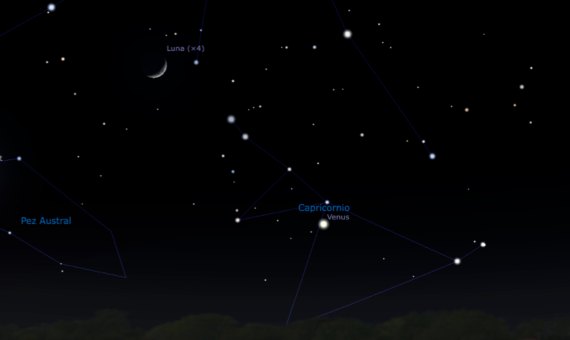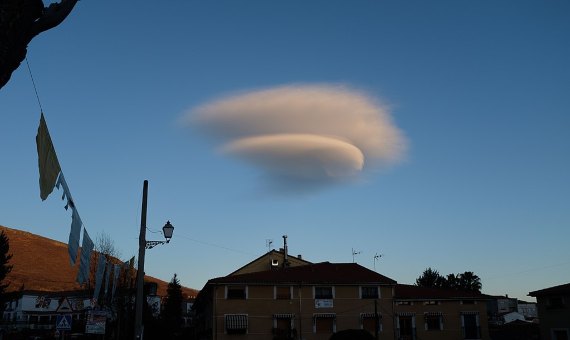Many astronomical objects can be seen in the sky such as stars, planets or meteors, artificial devices such as airplanes, satellites and balloon probes, and atmospheric phenomena such as sun dogs (parhelia). For the experienced observer it can be quite a spectacle, but a novice observer may easily confuse what is perfectly explainable with the paranormal. Here we offer some rational explanations for alleged UFO sightings:
Why are so many UFOs seen at sunset?
Something as simple as the planet Venus is one of the objects most confused with a UFO. It is currently visible to the naked eye right at sunset, not far from Jupiter, and it appears at the end of the day as the brightest star in the sky, only surpassed by the Moon. Its brightness can be dazzling, and the planet lies close to the horizon where the refraction produced by the atmosphere makes it appear to give off flashes of colour.

In addition to its striking colour and brightness, there is also an optical effect: a bright point on a dark background without any further reference can appear to be moving, something that must be taken into account so as not to confuse the planet with an object in motion.
Fireballs: the most spectacular shooting stars
While gazing up the night sky for a couple of hours, it is not uncommon to see a light suddenly appears and streak across the dome of the sky at great speed. This is what we know as a shooting star, whose origin lies in the material that the Earth encounters in its movement around the Sun. Most are grains of cometary dust less than a millimetre in size that end up as shooting stars, but occasionally a small meteoroid a few centimetres —or even metres— in size enters the atmosphere, creating a huge fireball that for a short time can shine brighter than the Moon; astronomers call these types of shooting stars bolides.
It is only a matter of linking together a few nights of observation to come across a bolide. You can increase your chances of spotting one by concentrating your observations during a meteor shower. During this month we have one of the most important of the year, the Geminids, with its maximum intensity on the night of December 14, although a week before and after you will also notice a great increase in meteoric activity, so don’t be obsessed with the night of the maximum. If the clouds allow it, December is an excellent month to head outside and observe these “perfectly identified flying objects”.
Spacecraft, but from this planet
Around the Earth there is a large network of artificial satellites that can be seen shortly after sunset or just before sunrise. The most striking are the low-earth-orbit satellites of the Iridium network, which during a very brief flash become the brightest points in the sky—brighter even than Venus. And that fleeting radiance tends to confuse inexperienced sky watchers.
The passage of the International Space Station overhead also attracts a lot of attention. While these events are less bright, they last for several minutes rather than just seconds, during which time a bright spot can be seen travelling across the sky. Other unique events such as the launch of mini-satellite chains, like StarLink, are even more spectacular, so much so that they have provoked complaints from some astronomers.
Unlike shooting stars, all these flashes in the sky can be accurately predicted through websites such as Heavens Above. As the time and position of these lights can be known in advance, they are one of the phenomena most enjoyed by amateur astronomers. However, orbiting satellites are not the only good candidates to be mistaken for UFOs. Sometimes the launch of space missions or the re-entry of space junk can give the impression of a phenomenon that is paranormal or of alien origin.
UFOs with regulation lights
When the description of the UFO includes red, green and white lights, the simplest explanation is that it is an airplane. In other cases, the landing and take-off lights —visible at night from many kilometres away— can be mistaken for a strange point of light that appears and disappears depending on the plane’s manoeuvres. What’s more, aircraft in flight at dusk or dawn can reflect the light of the Sun, generating a curious light that moves; if we add the contrails left by the engines, this phenomenon is easily confused with something bizarre, although in reality everything is perfectly explainable.
Mirages, clouds and coloured balloons
Some surprising optical atmospheric phenomena can also be mistaken for and catalogued as UFOs. The most spectacular and rare are mirages, caused by the difference in temperature between different layers of air, which can make objects appear to be floating above the horizon and doing other rather peculiar things.
A more common phenomena is known as a sun dog (formally called a parhelion), in which three suns are seen in the sky, or the halos that appear as a circle of light around the Moon. The nature of these cases is well known, and they fall into the category of optical phenomena caused by the reflection and refraction of light in the atmosphere; they are the same type of effect as those that generate rainbows.

Sometimes it is also possible to see strangely shaped clouds, such as the lenticular clouds that form near mountain peaks and are shaped like “flying saucers”. And things as curious as a release of balloons during a birthday party or a parachute landing at night can sometimes be mistaken for UFOs.
A lack of scientific evidence of flying saucers
Since the myth of the flying saucer was born, with the first alleged sighting in 1947, there has been no credible evidence of UFOs other than blurry photos and personal testimonies. None can be credited as scientific evidence. Not even the US Navy videos provided as evidence of the phenomenon in 2017 pass the sceptical analysis that finds an obvious explanation in a weather balloon and an airplane.
Moreover, paradoxically, although we live in the decade in which there are more cameras worldwide than ever before, hardly any new photos of possible UFOs have emerged among amateurs, and the groups of experts who most observe the sky, astronomers and meteorologists, have not raised the alarm about unexplained sightings either. Little seems to indicate that there is anything mysterious out there. What we do know is that we can observe a lot of colourful phenomena in the sky, among which can be found some of the most breathtaking sights in nature.
Borja Tosar
@borjatosar
Comments on this publication